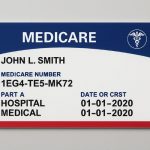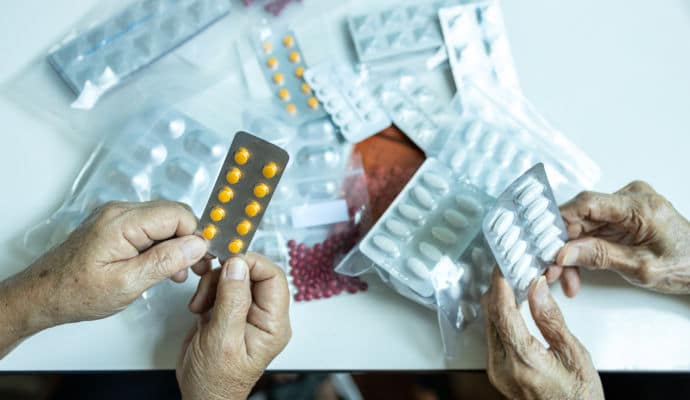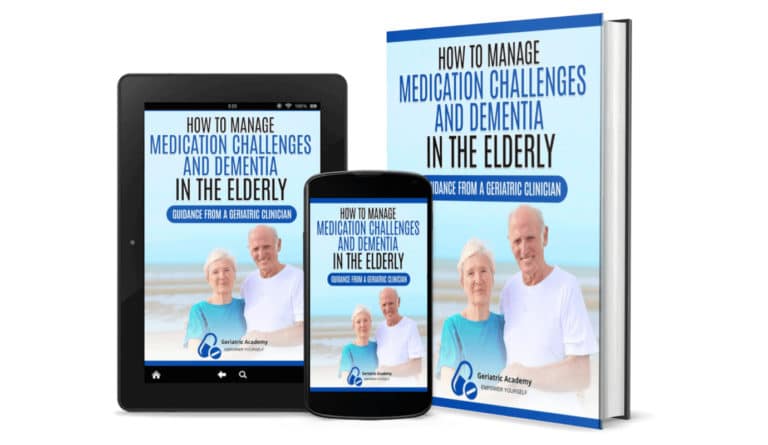When medication routines become complex or “non-standard,” it’s easy for mistakes or missed doses to happen. While caring for a family member, Paul Rothstein created a pill board system to make it easier to manage their medications.

It worked so well that he wanted to share his solution with other caregivers. Here, Paul explains how to create your own DIY pill board system to help avoid mistakes in your older adult’s medication routine.
Traditional Pill Organizers May Not Work Well for Complex Medication Routines
A typical pill organizer has compartments for the day of the week and the time of day—morning, afternoon, and night.
More complex pill organizer systems can also account for specific times of day or more frequent medication doses.
However, these pill organizers often don’t work as well when a medication routine is more complicated or includes non-pill formats.
Scenarios that don’t work well with a typical pill organizer include:
- The medication isn’t a pill. Some medicines are powders that must be mixed with liquids just before use, such as medical syrups, ointments, patches, or other formulations.
- A medication must be taken first thing in the morning, and then the person can’t eat for the next hour.
- A medication can’t be taken together with certain foods or beverages.
- A medication has to be taken with food, on an empty stomach, or with a full glass of water.
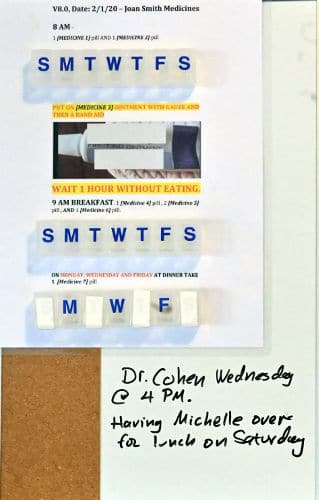
Our solution: a DIY pill board
A Flexible DIY Pill Board Can Make Medication Management Easier
When my relative’s medication routine was becoming more and more complex, I created a pill board to reduce medication errors and to include space for notes and reminders of upcoming appointments.
This pill board made life much easier for our family and my relatives’ caregivers.
It also received significant attention from nurses and occupational therapists. They thought it was a helpful and innovative solution.
A do-it-yourself (DIY) pill board like this is flexible for almost any medication routine, helps reduce mistakes, is easy for caregivers to refill, and is easy to make using inexpensive everyday items.
Overview
First, the basic idea is to create a pillbox “block” for each time of day medication is taken.
Next, put all the pill box “blocks” that are needed for one full day of medication onto as many pieces of paper as required.
Then, mount the paper(s) containing the pill box “blocks” onto a white erase board or sturdy piece of poster board.
Important: Before using it, make sure your pill board is correct by reviewing it with your older adult’s doctor or pharmacist.
Supplies needed:
- One pill box (like this) for each time of day that a person takes medications. For example, someone who takes medications at 10 am and 7 pm would need two separate pill boxes on their board.
- Double-sided foam mounting tape (like this)
- White erase board (like this one) or poster board (like this)
- Plain paper
- Pen or marker
- Tape
How to Build a DIY Pill Board
The pill board is a concept that can be easily customized to suit different situations.
For example, it works equally well whether it’s written by hand or typed on a computer. The goal is only to make the writing clear and easy to read.
In this example, the writing on the pill board was created on a computer and printed out.
In this example, the board itself is a white erase board with a cork border. You might have a whiteboard or a corkboard handy. Or, you might find it simpler to use a piece of poster or foam board instead.
1. Label Pill Box with Name and Date
Take a piece of paper and write the person’s name and the date this board was created at the top.
This board represents the person’s current medication routine. If their routine changes in the future, the board will need to be updated.
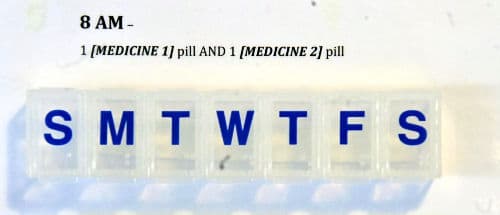
One pill box “block” where 8 AM is the first time of day that 2 medications will be taken
2. Create Pill Box with “Blocks”
Next, add the time of day when medications are first taken, and a pill box “block” for that time. This is also the place to include any special instructions.
In the close-up image above, we see that 8 AM is the first time of day that two medications will be taken. There are no special instructions for these two medications.
Write the full name of the medication and the number of pills required. You may also want to include the dosage as a reference.
Then, use double-sided foam mounting tape to stick the pill box underneath the writing.
Repeat these pill box “blocks” on the board as many times as needed for all the medication that’s taken during one full day.
For example, if your older adult takes pills at 8 AM, 12 noon, 4 pm, and 8 pm, they will need four of these pill box “blocks” to create their pill board.
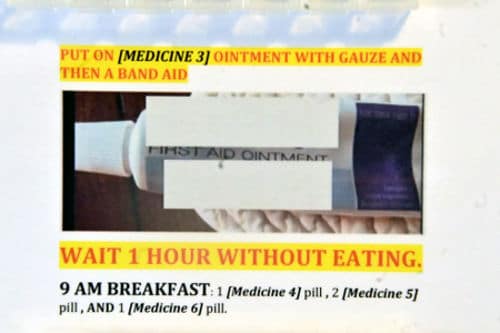
Adding a medication that isn’t in pill format, an ointment
3. Add Other Medications Besides Pills
In addition to pills, doctors commonly prescribe medications in various formats, such as ointments, liquids, creams, patches, or powders.
These medications need to be added to the pill board as well.
In this example, the image above shows a photo of a tube of prescription ointment that is part of the 8 AM pill box “block.”
The photo clearly shows what the ointment tube looks like. Special instructions are included to let caregivers know the person shouldn’t eat for an hour after the ointment is applied.
If you’d like to make sure a non-pill medication isn’t missed or forgotten, you could even write or type the directions in a different color.
In some cases, you may even be able to tape a small plastic bag “pocket” to the board and put the non-pill medication inside. For example, a small tube of ointment could fit inside a snack-size zip-top plastic baggie.

A pill box for a medication that’s only taken on Mondays, Wednesdays, and Fridays
4. Make Adjustments for Medications that Aren’t Taken Every Day
Sometimes, doctors will prescribe medications that shouldn’t be taken every day.
To accommodate this on the pill board and avoid confusion or mistakes, fill a dedicated pill box with that medication and tape it shut for the days not used.
In the image above, only the Monday, Wednesday, and Friday compartments are accessible. Those are the only days when this medication should be taken.
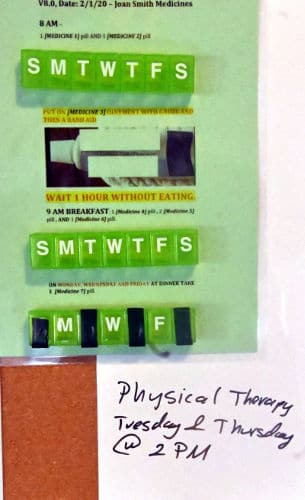
A second pill board
Create a Second Pill Board
Now that you’ve created your older adult’s pill board, you can see that it holds one week’s worth of medications.
Next, create a second pill board identical to the first, but in a different color so you can tell the two boards apart.
Why are two pill boards needed?
- One whole week of medications is always loaded up and ready to be used.
- When one board is finished, you can immediately switch to the second board.
- You’ll always have at least one week’s notice before any medication runs out and needs to be refilled.
Why are different colored boards needed?
In the photo of the second pill board above, you’ll see that the paper is green instead of the white paper used in the first pill board.
One board should be used all week, until all the medication is finished. Using a different color for a second board reduces the chances that anyone would get the two boards mixed up during the course of a week and use part of one board and part of another.
If you don’t have different colored paper, you could accomplish the same goal by adding a colored border, coloring the corners, etc. – anything that distinguishes one board from the other.
Customize Your Medication Pill Board for the Situation
Because everyone’s medications and dosage schedules vary, take the basic idea of the pill board and customize it to fit your older adult’s specific situation.
For example, if your older adult takes a specific medication only once every 2 weeks, you can prepare pill boards that reflect that schedule.
Or, some people might like laminating the paper to make it sturdier or waterproof.
The goal is to customize the pill board to suit your older adult’s medication needs.
Recommended for you:
- Prevent Dangerous Drug Interactions in Seniors with a Drug Interaction Checker
- 10 Tips for Safe Medication Management for Seniors
- 6 Common Medication Problems in Seniors and 6 Ways to Solve Them
Guest contributor: Paul Rothstein is an intellectual property and technology transactions attorney who unexpectedly found himself with a lot of time in hospital waiting rooms thinking about how life could be made easier for caregivers and the people they support and love.
About the Author

Connie is the founder of DailyCaring.com and was a hands-on caregiver for her grandmother for 20 years. (Grandma made it to 101 years old!) She knows how challenging, overwhelming, and all-consuming caring for an older adult can be. She also understands the importance of support, especially in the form of practical solutions, valuable resources, and self-care tips.






